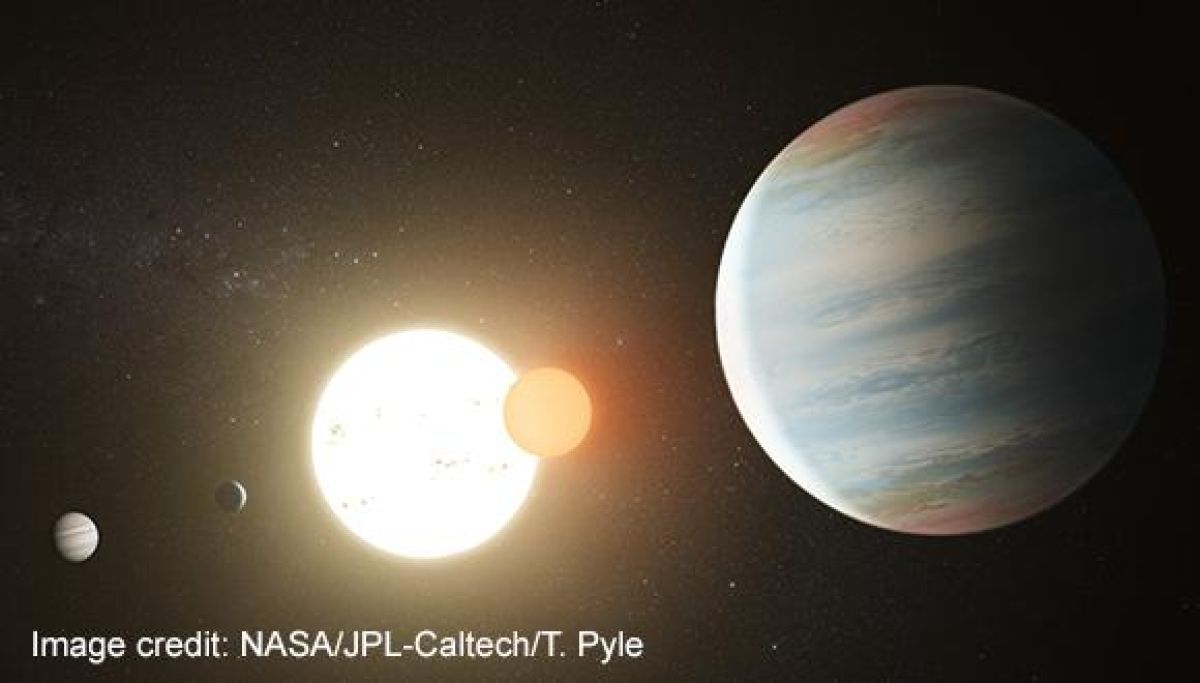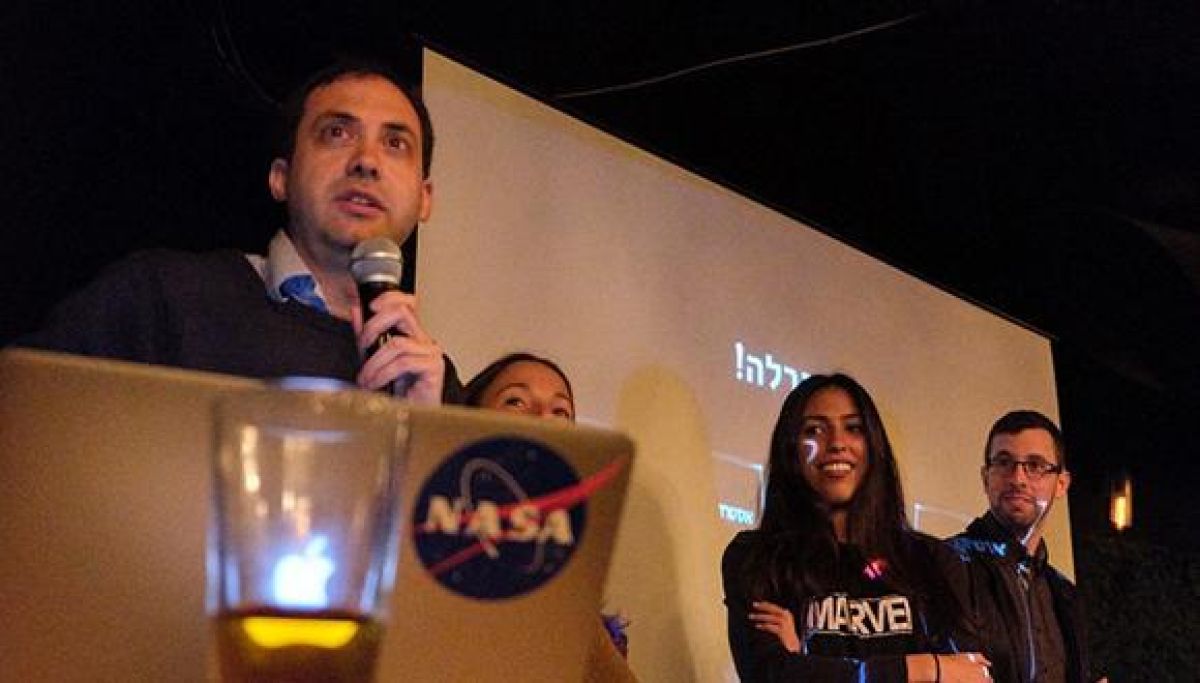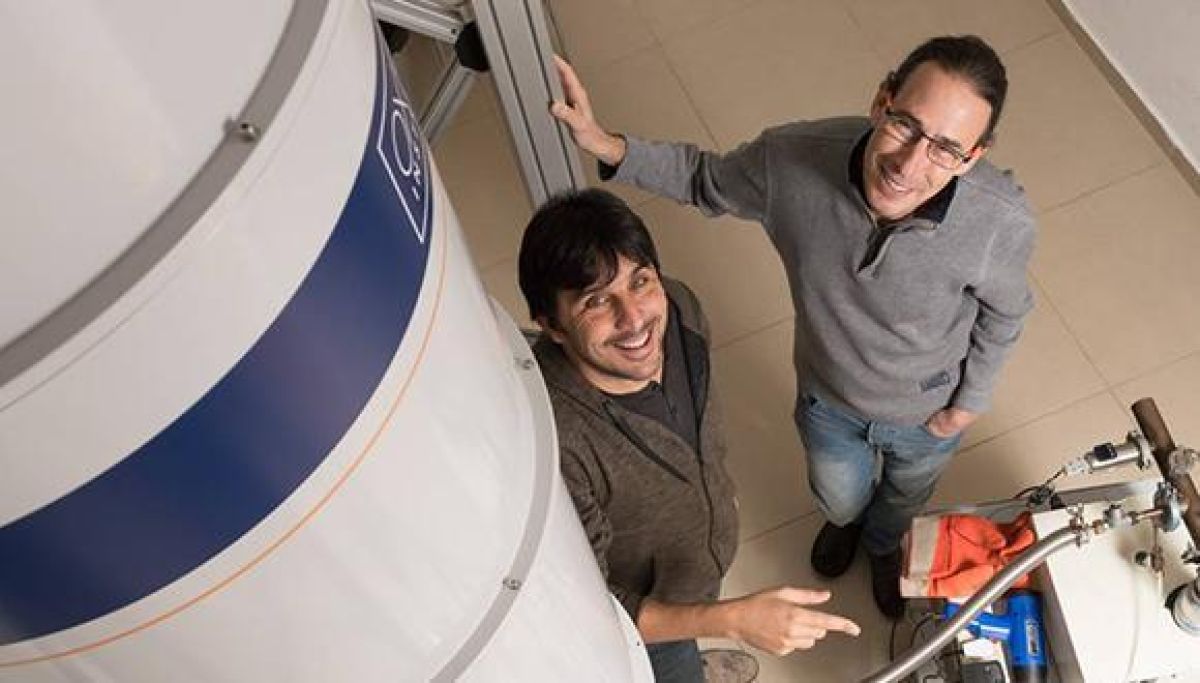Tag: Astronomy
Discovery of a binary star orbited by three planets
Discovery by a team of researchers, including Prof. Tsevi Mazeh from the School of Physics and Astronomy
Astronomers have discovered a third planet in the Kepler-47 system, turning the system’s to be one of the most interesting known binary stars.
Using data from NASA’s Kepler space telescope, a team of researchers, including Prof. Tsevi Mazeh from TAU, detected a new Neptune-to-Saturn-size planet orbiting between two previously known planets. The system is now known to include two suns in a very close orbit, circled by three planets. This is the only known double star with more than one circumbinary planet known.
Image credit: NASA
Over 400 People Attend Launch of “Astronomy on Tap”
The School of Physics and Astronomy inaugurated a new public outreach activity – short astronomy-related presentations at a bar.
The first event was held at the Kanta Bar in Tel Aviv on Tuesday, April 2, 2019. PhD student Meir Zeilig-Hess spoke about his research on supermassive black holes in the centers of galaxies, and Master’s student Natalie Lubelchick talked about her research in deciphering the explosions of stars. New faculty member, Dr. Iair Arcavi, and PhD student Dalya Baron hosted the event and reviewed the month’s “astronomy in the news”. Astronomical prizes were given to attendees who sent questions to the speakers during the event.
Astronomy on Tap is expected to take place roughly once a month in the same format. The events are free and open to the public. Updates will be provided through the Astronomy on Tap mailing list and Facebook page (in Hebrew). Links to photos and videos of each event will be posted to the website. For further information, please contact the organizer of the event, Dr. Iair Arcavi.
Photo: From left: Dr. Iair Arcavi, Dalya Baron, Natalie Lubelchick, Meir Zeilig-Hess. Photo: Ofir Hochberg
Conversations in the Clean Room
At the shared laboratories of the Center for Nanoscience and Nanotechnology, casual conversations between scientists can lead to breakthroughs
A chemist and a physicist walk into a clean room. No, this is not the one about how many people it takes to change a light bulb. Nor is it the one about two Israelis and three opinions. This is a true story about how two doctoral students from different fields got talking and realized that they may be able to use chemistry to solve a nagging problem in physics. “These students were the best kind – curious and open to new ideas and different ways of approaching a problem,” says Prof. Gil Markovich of the Raymond and Beverly Sackler School of Chemistry. Prof. Yoram Dagan, Raymond and Beverly Sackler School of Physics and Astronomy, nods in agreement.
Markovich and Dagan were the students’ respective PhD advisors and quickly saw the benefit of collaborating. In their research, they sought a solution to prevent damage to the surface of semiconductors – small components that control electrical current in devices such as computers and mobile phones, which damage the functioning of the devices.
For this kind of research, a particularly sterile laboratory is required. The special conditions in the “clean room” include a constant temperature of 20 degrees, 50 percent humidity, and a very powerful filter that prevents the entry of dust particles into the laboratory space and is responsible for creating a sterile work environment. These conditions are essential for the production of certain materials, especially electronic chips, which can be disrupted by something as tiny as a grain of dust.
From cell phones to thermal cameras
The scientists are using a chemical rather than physical process to create an electrical insulating thin film the thickness of a single atom. According to Dagan, “Unlike in physics, where non-organic materials are used, we used organic compounds to get the components that create the atom-thick layer.” In the process carried out by the scientists, they heated organic compounds to the point of dissolution. Once they touch the surface, they receive additional energy and break down until the process stops on its own. “This creates only a single layer of the insulating material, because there is not enough energy to form another layer,” Dagan explains. “In a cheap and rapid chemical process, we were able to offer an alternative to complicated and costly processes, and even to achieve a better result.”
Their invention could improve microelectronics in all the devices we carry in our pockets and have in our homes by making them faster, more efficient and more compact. “This is a long-term project – an idea that may be implementable twenty years down the line. Yet exploring this basic physics problem using nano-chemistry led us to an application that can be realized today,” says Dagan.
Markovich and Dagan have teamed up with industry experts for guidance in applying their technology to improve resolution in infrared cameras used for defense and security installations. The Israel Innovation Authority (formerly the Office of the Chief Scientist) has invested in the project with a grant reserved solely for projects that have a good chance to be commercialized in Israel. “It all begins, though, with basic science. Basic science is the foundation of knowledge. When we discover new possibilities and new materials, applications can grow,” stresses Dagan.
Collaboration opens new possibilities
Markovich and Dagan share a passion for unlocking the secrets of the universe: “We are both interested in origins,” says Dagan. “Gil researches the interaction of minerals with amino acids and DNA – the original building blocks of life. I am interested in the fundamental properties of matter and materials. I would not think up chemical approaches to physical problems by myself. Our collaboration is opening up new possibilities.” says Dagan.
“This has been a fun ride,” adds Markovich. “First, Yoram is a nice person. And I never worked on these kinds of problems before. We have ideas for cooperation on chemical ways to create new materials for quantum computing. The future is wide open.”
Featured iage:Prof. Gil Markovich and Prof. Yoram Dagan (Photo: Yoram Reshef)
TAU-led team discovers new way black holes are “fed”
These “giant monsters” were observed suddenly devouring gas in their surroundings
Supermassive black holes weigh millions to billions times more than our sun and lie at the center of most galaxies. A supermassive black hole several million times the mass of the sun is situated in the heart of our very own Milky Way.
Despite how commonplace supermassive black holes are, it remains unclear how they grow to such enormous proportions. Some black holes constantly swallow gas in their surroundings, some suddenly swallow whole stars. But neither theory independently explains how supermassive black holes can “switch on” so unexpectedly and keep growing so fast for a long period.
A new Tel Aviv University-led study published today in Nature Astronomy finds that some supermassive black holes are triggered to grow, suddenly devouring a large amount of gas in their surroundings.
Following the light
In February 2017, the All Sky Automated Survey for Supernovae discovered an event known as AT 2017bgt. This event was initially believed to be a “star swallowing” event, or a “tidal disruption” event, because the radiation emitted around the black hole grew more than 50 times brighter than what had been observed in 2004.
However, after extensive observations using a multitude of telescopes, a team of researchers led by Dr. Benny Trakhtenbrot and Dr. Iair Arcavi, both of TAU’s Raymond & Beverly Sackler School of Physics and Astronomy, concluded that AT 2017bgt represented a new way of “feeding” black holes.
“The sudden brightening of AT 2017bgt was reminiscent of a tidal disruption event,” says Dr. Trakhtenbrot. “But we quickly realized that this time there was something unusual. The first clue was an additional component of light, which had never been seen in tidal disruption events.”
Dr. Arcavi, who led the data collection, adds, “We followed this event for more than a year with telescopes on Earth and in space, and what we saw did not match anything we had seen before.”
The observations matched the theoretical predictions of another member of the research team, Prof. Hagai Netzer, also of Tel Aviv University.
“We had predicted back in the 1980s that a black hole swallowing gas from its surroundings could produce the elements of light seen here,” says Prof. Netzer. “This new result is the first time the process was seen in practice.”
Mysterious re-activation
Astronomers from the U.S., Chile, Poland and the U.K. took part in the observations and analysis effort, which used three different space telescopes, including the new NICER telescope installed on board the International Space Station.
One of the ultraviolet images obtained during the data acquisition frenzy turned out to be the millionth image taken by the Neil Gehrels Swift Observatory — an event celebrated by NASA, which operates this space mission.
The research team identified two additional recently reported events of black holes “switched on,” which share the same emission properties as AT 2017bgt. These three events form a new and tantalizing class of black hole re-activation.
“We are not yet sure about the cause of this dramatic and sudden enhancement in the black holes’ feeding rate,” concludes Dr. Trakhtenbrot. “There are many known ways to speed up the growth of giant black holes, but they typically happen during much longer timescales.”
- 1
- 2





